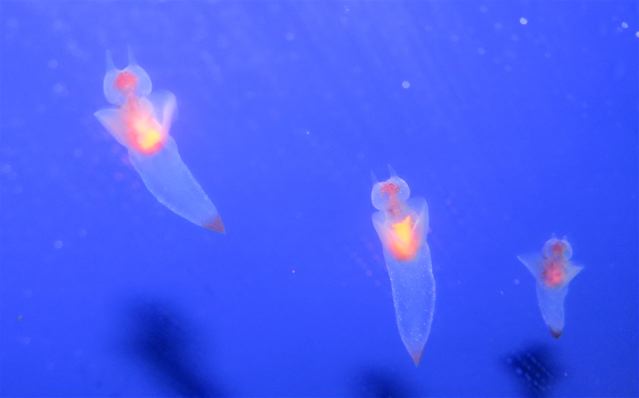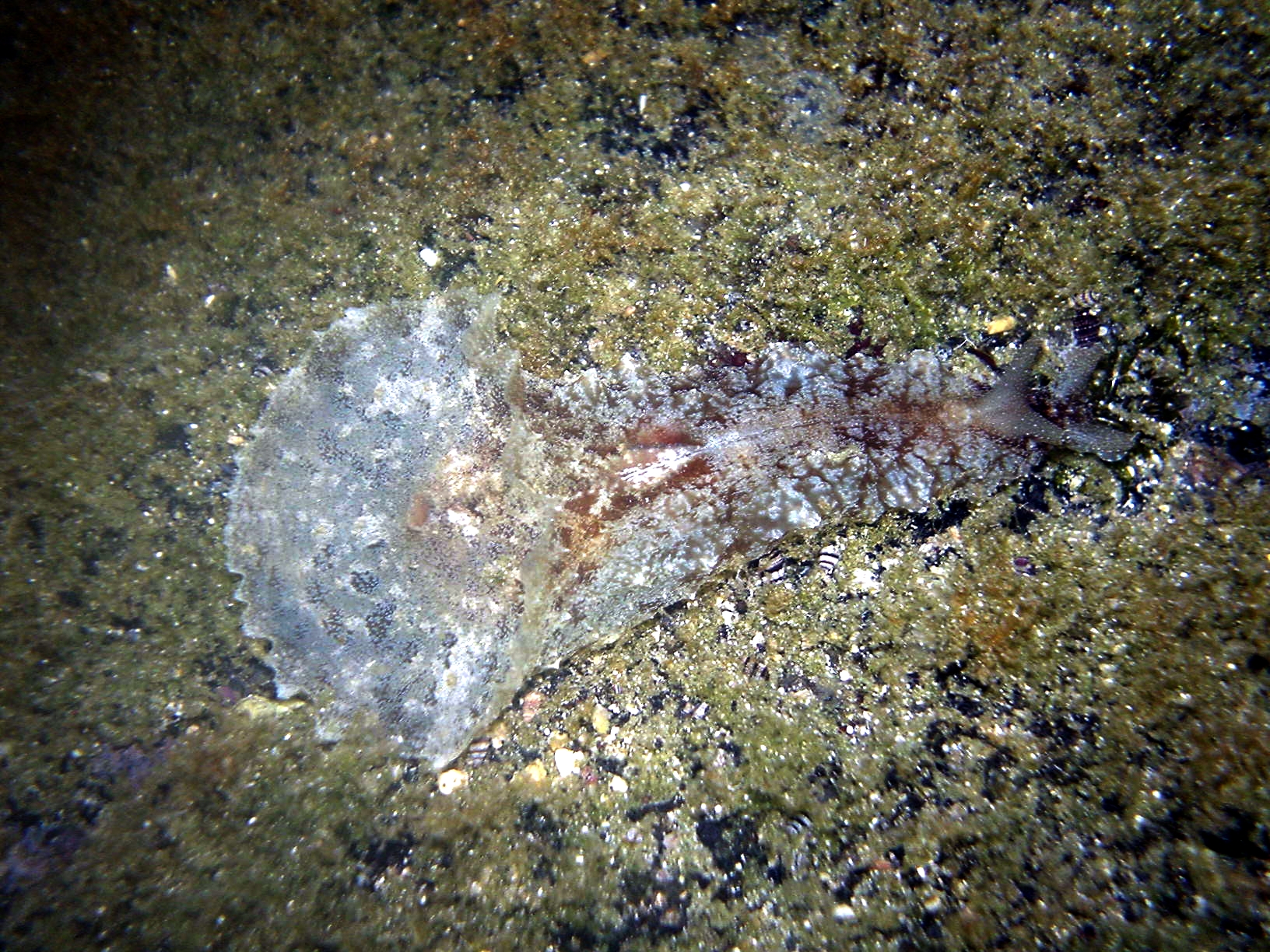|
Opisthobranch
Opisthobranchs () is a now informal name for a large and diverse group of specialized complex gastropods which used to be united in the subclass Opisthobranchia. That taxon is no longer considered to represent a monophyletic grouping. Euopisthobranchia is a taxon containing a revised collection of opisthobranchs, and that taxon is considered monophyletic. Euopisthobranchia does not include some "traditional" opisthobranchs such as the Sacoglossa and the Acochlidiacea. The subclass Heterobranchia now contains all the species which used to be assigned to Opisthobranchia, plus all the species in the Pulmonata. The subclass Opisthobranchia included species in the order Cephalaspidea (bubble shells and headshield slugs), the sacoglossans, anaspidean sea hares, pelagic sea angels, sea butterflies, and many families of the Nudibranchia. ''Opisthobranch'' means "gills behind" (and to the right) of the heart. In contrast, ''Prosobranch'' means ''gills in front'' (of the heart). ... [...More Info...] [...Related Items...] OR: [Wikipedia] [Google] [Baidu] |
Acochlidiacea
Acochlidiacea, common name acochlidians, are a Taxonomy (biology), taxonomic clade of very unusual sea snails and sea and freshwater slugs, aquatic animal, aquatic gastropod mollusks within the large clade Heterobranchia. Acochlidia is a variant spelling. Description These are mostly very small animals, without a Mollusc shell, shell or gills, distinguished by the visceral mass being sharply set off from the rest of the body. Being a small group with only 47 species worldwide known in 2023,MolluscaBase eds. (2021)MolluscaBase. Acochlidiimorpha.Accessed on 2023-02-13. this group has been the subject of active research since 2010, by which date only 32 species were named. These slugs are morphologically and biologically highly aberrant and diverse, comprising a series of unusual characters (e.g. secondary gonochorism, lack of copulatory organs, asymmetric radulae). Most acochlidians live interstitially in marine sands, while some have conquered limnic systems (uniquely within o ... [...More Info...] [...Related Items...] OR: [Wikipedia] [Google] [Baidu] |
Sacoglossa
Sacoglossa are a superorder of small sea slugs and sea snails, marine gastropod mollusks that belong to the clade Heterobranchia known as sacoglossans. There are 284 valid species recognized within this superorder. Sacoglossans live by ingesting the cellular contents of algae, hence they are sometimes called "sap-sucking sea slugs". Some sacoglossans simply digest the fluid which they suck from the algae, but in some other species, the slugs sequester and use within their own tissues living chloroplasts from the algae they eat, a very unusual phenomenon known as kleptoplasty, for the "stolen" plastids. This earns them the title of the "solar-powered sea slugs", and makes them unique among metazoan organisms, for otherwise kleptoplasty is known only among other euthyneurans and single-celled protists. The Sacoglossa are divided into two clades - the shelled families (Oxynoacea) and the shell-less families (Plakobranchacea). The four families of shelled species are Cylindrobul ... [...More Info...] [...Related Items...] OR: [Wikipedia] [Google] [Baidu] |
Gymnosomata
Sea angels (clade Gymnosomata) are a large group of small free-swimming sea slugs, classified into six separate families. They are pelagic opisthobranchs in the clade Gymnosomata within the larger mollusc clade Heterobranchia. Sea angels were previously considered to be pteropods. Sea angels are also sometimes known as "sea butterflies" but this is potentially misleading because the family Clionidae is just one of the families within this clade, and the term "sea butterfly" is also applied to the shelled Thecosomata. Recent molecular data suggest the Gymnosomata form a sister group to the Thecosomata (other planktonic, weakly or nonmineralized gastropods), but this long-standing hypothesis has also had some recent detractors. Distribution These organisms have a wide geographic range, from polar regions, under sea ice, to equatorial (tropic) seas. From spring to autumn, sea angels live at a depth of 200 m in the Sea of Okhotsk. In winter, they migrate to the coast of north ... [...More Info...] [...Related Items...] OR: [Wikipedia] [Google] [Baidu] |
Heterobranchia
Heterobranchia, the heterobranchs (meaning "different gill"), is a taxonomic clade of snails and slugs, which includes marine, aquatic, and terrestrial gastropod molluscs. Heterobranchia is one of the main clades of gastropods. Currently Heterobranchia comprises two groups: the opisthobranchs, and the pulmonates. Diversity The two subdivisions of this large clade are quite diverse: * Opisthobranchia are virtually all marine species, some shelled and some not, and comprise about 25 families and 2000 species of the bubble shells, the seaslugs, as well as the sea hares. The internal organs of the opisthobranchs have undergone detorsion (unwinding of the viscera that were twisted during torsion). * The Pulmonata comprises about 20000 species, includes the majority of land snails and slugs, many freshwater snails, and a small number of marine species. The mantle cavity of the Pulmonata is modified into an air-breathing organ. They are also characterized by detorsion a ... [...More Info...] [...Related Items...] OR: [Wikipedia] [Google] [Baidu] |
Cylindrobullida
''Cylindrobulla'' is a genus of sea snails or bubble snails, marine gastropod mollusks in the clade Sacoglossa. ''Cylindrobulla'' is the type genus of the family Cylindrobullidae and it is the only genus in the family. Taxonomy The suborder Cylindrobulloidea used to be recognized as monogeneric suborder; in other words there was only one family in the suborder, the family Cylindrobullidae, and only one genus ''Cylindrobulla''. 1996 taxonomy It was treated by Jensen (1996) as a sister group of Sacoglossa and placed it in the new order Cylindrobullacea. 1998 taxonomy Mikkelsen (1998) has argued that the genus ''Cylindrobulla'' actually belongs in Oxynoacea within shelled Sacoglossa. This change in taxonomy was suggested on the basis of the similarity in many characteristics: digestive, sexual, pallial (= concerning the mantle), and the nervous system. 2005 taxonomy According to the taxonomy by Bouchet & Rocroi (2005), is the Cylindrobullidae the only family in the s ... [...More Info...] [...Related Items...] OR: [Wikipedia] [Google] [Baidu] |
Gastropod
Gastropods (), commonly known as slugs and snails, belong to a large Taxonomy (biology), taxonomic class of invertebrates within the phylum Mollusca called Gastropoda (). This class comprises snails and slugs from saltwater, freshwater, and from the land. There are many thousands of species of sea snails and sea slug, slugs, as well as freshwater snails, freshwater limpets, land snails and slugs. The class Gastropoda is a diverse and highly successful class of mollusks within the phylum Mollusca. It contains a vast total of named species, second only to the insects in overall number. The fossil history of this class goes back to the Furongian, Late Cambrian. , 721 family (taxonomy), families of gastropods are known, of which 245 are extinct and appear only in the fossil record, while 476 are currently neontology, extant living fossil, with or without a fossil record. Gastropoda (previously known as univalves and sometimes spelled "Gasteropoda") are a major part of the phylum Mo ... [...More Info...] [...Related Items...] OR: [Wikipedia] [Google] [Baidu] |
Thecosomata
The Thecosomata (collective/plural: ''thecosomes'', meaning "case/shell-body"), or sea butterflies, are a taxonomic suborder of small, pelagic, free-swimming sea snails known as holoplanktonic opisthobranch gastropod mollusks, in the order Pteropoda (also included within the informal group Opisthobranchia). Most pteropods have some form of calcified shell, although it is often very light, even translucent. The sea butterflies include some of the world's most abundant gastropod species; as their large numbers are an essential part of the ocean food chain, they are a significant contributor to the oceanic carbon cycle. Morphology Unlike other sea snails, or even land snails, sea butterflies float and swim freely through the ocean, traveling along with the currents. This has led to a number of evolutionary adaptations in their bodies, including complete or near-complete loss of the shell and the gill in several families. Their gastropodal foot has also taken the form of two ... [...More Info...] [...Related Items...] OR: [Wikipedia] [Google] [Baidu] |
Aplysiomorpha
The order Aplysiida, commonly known as sea hares (''Aplysia'' species and related genera), are medium-sized to very large opisthobranch gastropod molluscs with a soft internal shell made of protein. These are marine gastropod molluscs in the superfamilies Aplysioidea and Akeroidea. The common name "sea hare" is a direct translation from , as the animal's existence was known in Roman times. The name derives from their rounded shape and from the two long rhinophores that project upward from their heads and that somewhat resemble the ears of a hare. Taxonomy Many older textbooks and websites refer to this suborder as "Aplysiida". The original author Paul Henri Fischer described the taxon Aplysiida at unspecified rank above family. In 1925 Johannes Thiele established the taxon Aplysiida as a suborder. 2005 taxonomy Since the taxon Aplysiida was not based on an existing genus, this name is no longer available according to the rules of the ICZN. Aplysiida has been replace ... [...More Info...] [...Related Items...] OR: [Wikipedia] [Google] [Baidu] |
Umbraculida
Umbraculoidea is a superfamily of unusual false limpets with a thin soft patelliform shell, marine gastropod molluscs in the clade Umbraculida, within the clade Euopisthobranchia. There are two families in this superfamily, which is listed as the only superfamily in the clade Umbraculida within the informal group Opisthobranchia in the taxonomy of Bouchet & Rocroi (2005). Taxonomy A study by Grande ''et al.'', published in 2004, concluded that Umbraculoidea was a sister clade to the Cephalaspidea The order Cephalaspidea, also known as the headshield slugs and bubble snails, is a major taxon of sea slugs and bubble snails, marine (ocean), marine gastropod mollusks within the larger clade Euopisthobranchia. Bubble shells is another commo ... ( Acteonoidea excluded). 2005 taxonomy Umbraculoidea contains two families: *Family Umbraculidae *Family Tylodinidae 2010 taxonomy Jörger et al. (2010) moved Umbraculoidea to the Euopisthobranchia. References External links ... [...More Info...] [...Related Items...] OR: [Wikipedia] [Google] [Baidu] |
Sea Butterflies
The Thecosomata (collective/plural: ''thecosomes'', meaning "case/shell-body"), or sea butterflies, are a taxonomic suborder of small, pelagic, free-swimming sea snails known as holoplanktonic opisthobranch gastropod mollusks, in the order Pteropoda (also included within the informal group Opisthobranchia). Most pteropods have some form of calcified shell, although it is often very light, even translucent. The sea butterflies include some of the world's most abundant gastropod species; as their large numbers are an essential part of the ocean food chain, they are a significant contributor to the oceanic carbon cycle. Morphology Unlike other sea snails, or even land snails, sea butterflies float and swim freely through the ocean, traveling along with the currents. This has led to a number of evolutionary adaptations in their bodies, including complete or near-complete loss of the shell and the gill in several families. Their gastropodal foot has also taken the form of ... [...More Info...] [...Related Items...] OR: [Wikipedia] [Google] [Baidu] |
Sea Hares
The order Aplysiida, commonly known as sea hares (''Aplysia'' species and related genera), are medium-sized to very large opisthobranch gastropod molluscs with a soft internal shell made of protein. These are marine gastropod molluscs in the superfamilies Aplysioidea and Akeroidea. The common name "sea hare" is a direct translation from , as the animal's existence was known in Roman times. The name derives from their rounded shape and from the two long rhinophores that project upward from their heads and that somewhat resemble the ears of a hare. Taxonomy Many older textbooks and websites refer to this suborder as "Aplysiida". The original author Paul Henri Fischer described the taxon Aplysiida at unspecified rank above family. In 1925 Johannes Thiele established the taxon Aplysiida as a suborder. 2005 taxonomy Since the taxon Aplysiida was not based on an existing genus, this name is no longer available according to the rules of the ICZN. Aplysiida has been replaced in ... [...More Info...] [...Related Items...] OR: [Wikipedia] [Google] [Baidu] |




